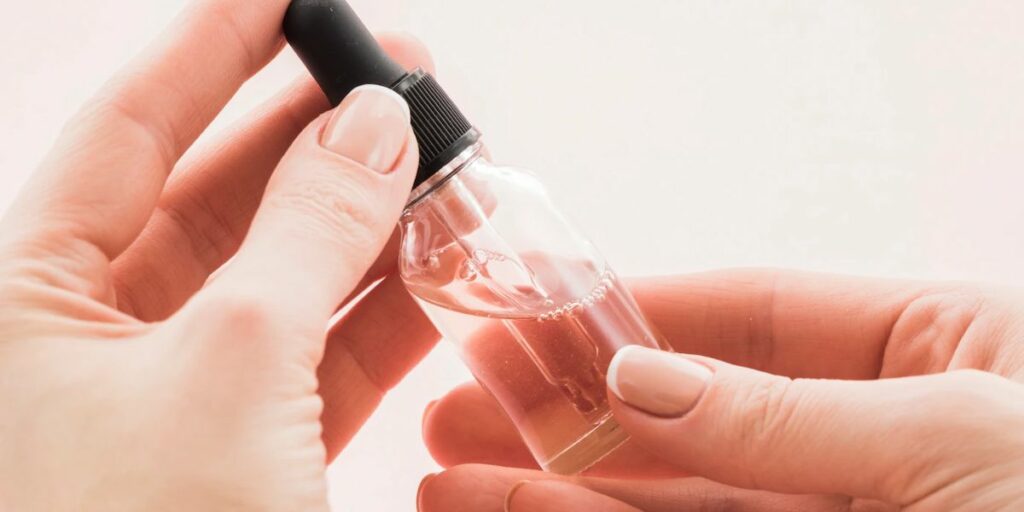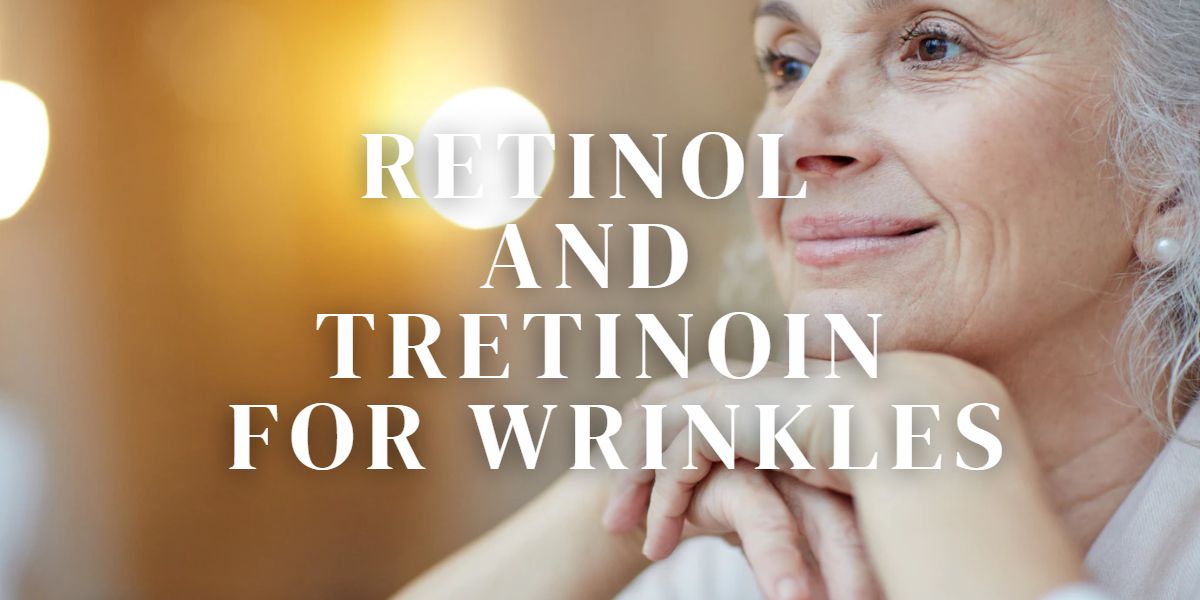Retinol And Tretinoin for Wrinkles: All You Need to Know
Jump To:
Are you trying to decide which anti-aging skincare product to use to reduce the appearance of wrinkles? If so, you may have come across the terms retinol and tretinoin. Both are popular ingredients in anti-aging products. They have the ability to improve the look of fine lines and creases. But what’s the difference between the two, and which one is right for you?
In this tretinoin vs retinol blog post, we’ll explore the key differences between retinol and tretinoin and help you determine which one is best for your skin’s needs.
Retinol
Retinol is a type of vitamin A that is commonly present in skin care products. It may reduce fine lines and wrinkles. Retinol works by increasing the production of collagen, a protein that helps to keep the skin looking firm and smooth. It can also help to unclog pores and improve the texture of the skin.
Retinol is available in a variety of strengths and formulations, and it is often found in creams, serums, and other topical products. Some people may experience mild aftereffects when using retinol, such as flakiness, peeling, or redness, but these effects typically subside with continued use.
Tretinoin
Tretinoin is only available by prescription. It is a form of vitamin A and is used to treat acne and skin aging. Tretinoin works by increasing skin cell turnover process and decreasing the production of keratin, a protein that can block pores. It can also help to reduce the appearance of fine lines and improve the overall texture and tone of the skin.
Tretinoin is over-the-counter, available in cream, gel, and liquid form. It is typically applied to the affected area once or twice a day as directed by a doctor. It is important to use tretinoin exactly as prescribed, as overuse or improper use can cause skin irritation.
What are the common side effects on the skin?
Retinol and tretinoin are both forms of vitamin A that are used in skincare products. They are known to be effective at improving the appearance of fine lines and uneven skin tone, but they can also cause some side effects.

Common side effects of retinol and tretinoin include:
- Both retinol and tretinoin can cause the skin to become dry and flaky, especially when you first start using them. This is because they can cause the outer layer of the skin to peel off, revealing the new, smoother skin underneath. To help reduce flakiness, it is important to use a moisturizer and apply a thin layer of the product, rather than a thick one.
- Some people may experience redness and irritation when using retinol or tretinoin, especially if they have sensitive skin. If this occurs, you may need to use the product less frequently or dilute it with a moisturizer to reduce the irritation.
- Both retinol and tretinoin can make the skin more sensitive to the sun. So, it is important to use a broad-spectrum sunscreen with an SPF30 or higher when using these products.
- Some people may experience other tretinoin and retinol side effects, such as stinging, burning, or itching. If these side effects are severe or do not go away, you should stop using the product and speak to a dermatologist.
It is important to follow the instructions for using retinol or tretinoin products. Using them too frequently or in too high of a concentration can increase the risk of side effects. You should also speak to a dermatologist before using these products if you have sensitive skin or are pregnant or nursing.
Does retinol work well on acne?
Yes!
Retinol functions in several ways. Retinol exfoliates the epidermis, or top layer of skin, to clear away debris, dead skin cells, and oil from pores. This may aid in preventing the development of zits.
Retinol also functions by really penetrating your skin, which is how it differs from many other acne treatments. Tiny molecules enter the dermis and promote the synthesis of collagen and elastin.
Over time, both of these substances lessen acne scarring and pore appearance.
Retinol and Tretinoin: Which is Better?
Tretinoin and Retinol share many constituents, yet they differ significantly in some important ways. Retinol is a much slower active ingredient than tretinoin. Unlike retinol, Tretinoin is also a retinoid. Tretinoin is a concentrated form of pure retinoic acid.
Only after retinol has been applied, stored, and progressively absorbed by your skin does it transform into retinoic acid. This makes Tretinoin particularly successful at the same things Retinol is good at in a more direct approach, notably when treating acne. Tretinoin might initially cause reddening, itching, and peeling for sensitive skin types.
So, are these both beneficial to improve the appearance of wrinkles?
Users of retinol might need to wait a little longer to see results, but they won’t have to deal with the bothersome side effects; in other words, they’ll avoid the bad and benefit from it all.
This is the reason tretinoin is not available in over-the-counter cosmetic products; instead, it is exclusively available as a prescription medicine, including Retin-A. Ask your dermatologist whether tretinoin-containing products are suitable for your needs and the nature of your skin.
Other than that, anti-aging creams containing retinol as an active component offer the least uncomfortable and most accessible option available.
Using retinol and tretinoin together in a skincare regime

It is generally not recommended to use retinol and tretinoin together in a skincare routine. This is because both retinol and tretinoin are forms of vitamin A and can have similar effects on the skin. Using them together may increase the risk of irritation and other side effects.
If you are considering using both retinol and tretinoin, it is important to speak with a dermatologist or other qualified healthcare provider. They can help you determine the appropriate skincare routine for your specific skin concerns and needs.
In general, it is best to introduce new products into your skincare routine slowly and to be mindful of any potential irritation or sensitivity. If you are using a product that contains retinol, it is recommended to start with a lower concentration. Use it only a few times a week, gradually increasing the frequency as your skin becomes used to the product.
It is also important to use a broad-spectrum sunscreen with an SPF of 30 or higher when using any product that contains retinol or tretinoin, as these products can increase the skin’s sensitivity to the sun.
Tretinoin and Retinol key differences
If you’re considering using one of these products to improve the appearance of the skin, understand the tretinoin and retinol key differences
Strength
Tretinoin is more concentrated than retinol. Tretinoin is a prescription-only medication, while retinol is available over the counter.
Type of Vitamin
Tretinoin is a form of vitamin A called all-trans retinoic acid, while retinol is a less potent form of vitamin A called retinol ester.
Speed of Action
Tretinoin tends to work faster than retinol, as it is a more potent form of vitamin A. However, this also means that it can be more irritating to the skin, especially when you first start using it.
Side Effects
Tretinoin can cause after-effects such as flakiness, peeling, and redness. However, retinol is generally less irritating to the skin.
Best for
Although, both are effective at reducing the signs of aging. Tretinoin is typically for people with more severe signs of aging, while retinol is suitable for people with mild to moderate wrinkles.
Ultimately, the best choice for you will depend on your skin’s needs and tolerance for different ingredients. It’s always a good idea to speak with a dermatologist or skincare professional before starting a new skincare routine.
Do retinoids really reduce wrinkles?

Retinoids are known to improve the appearance of the skin. They work by increasing collagen production, which helps to firm and plump the skin, and by increasing cell turnover, which helps to smooth out the surface of the skin. There are several different types of retinoids, including retinol, tretinoin, and tazarotene.
Retinoid can be effective in reducing the appearance of wrinkles, but it is important to use them consistently and as directed. Retinoid may take several weeks or months to see results, and it is important to use sunscreen during the daytime to protect your skin from the sun’s damaging UV rays, as retinoids can increase your skin’s sensitivity to the sun.
It is always a good idea to consult with a dermatologist or other healthcare provider before starting any new skincare regimen. They can help you determine the best retinoid product and treatment plan for your specific skin type and concerns.
How do topical retinoid work for wrinkles?
Topical retinoids are a type of medication that is applied to the skin and are often used to treat a variety of skin conditions, including wrinkles. They work by increasing cell turnover and promoting the production of collagen, which can help improve the appearance of fine lines and wrinkles.
Retinoid work by binding to specific receptors in the skin cells called retinoic acid receptors (RARs). When retinoid bind to these receptors, they stimulate the production of new skin cells and the synthesis of collagen, which can help to improve the appearance of fine lines and wrinkles. In addition, retinoid can also help to increase the thickness and elasticity of the skin, which can also contribute to a more youthful appearance.
There are several different types of topical retinoid available, including tretinoin, adapalene, and tazarotene. They are typically available by prescription only and are usually applied to the skin once or twice daily. It is important to use topical retinoids as directed by a healthcare provider, as they can cause skin irritation and flakiness when used improperly.
Wrapping up
Retinol vs tretinoin: In conclusion, both retinol and tretinoin are effective at reducing the appearance of wrinkles and improving the overall appearance of the skin. However, tretinoin is a more potent form of vitamin-A and may produce more rapid and noticeable results. It is also available only by prescription and can cause side effects such as dryness, redness, and irritation. Retinol, on the other hand, is a weaker form of vitamin-A and may be more suitable for people with sensitive skin. It is available over the counter.
Ultimately, the decision between retinol and tretinoin will depend on your individual skin concerns and tolerance for potential side effects. It is important to speak with a dermatologist or skincare professional to determine the best option for you. Remember to always use sunscreen when using these products, as they can increase the skin’s sensitivity to the sun. With consistent use and proper skin care, retinol and tretinoin can help improve the appearance of wrinkles.

